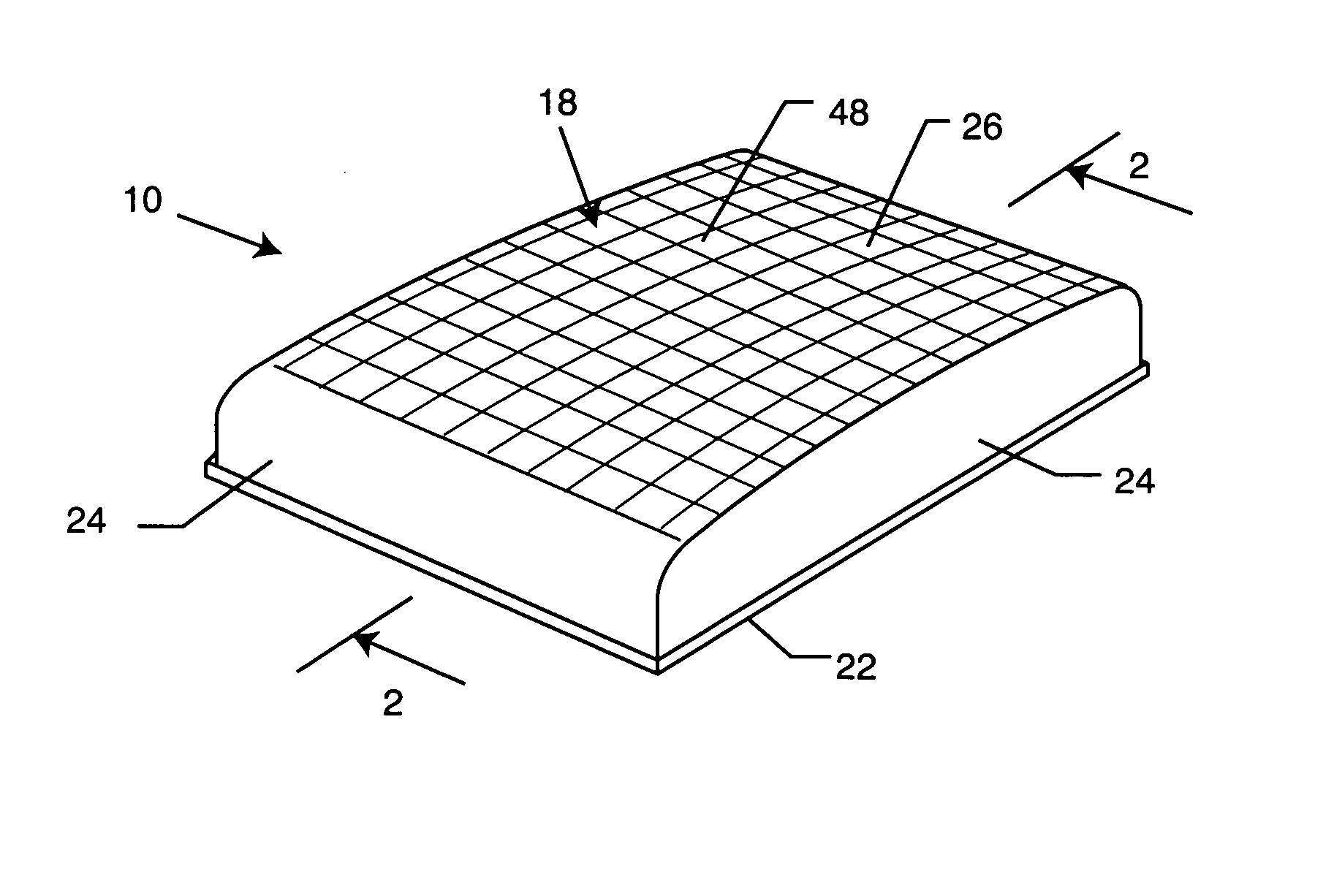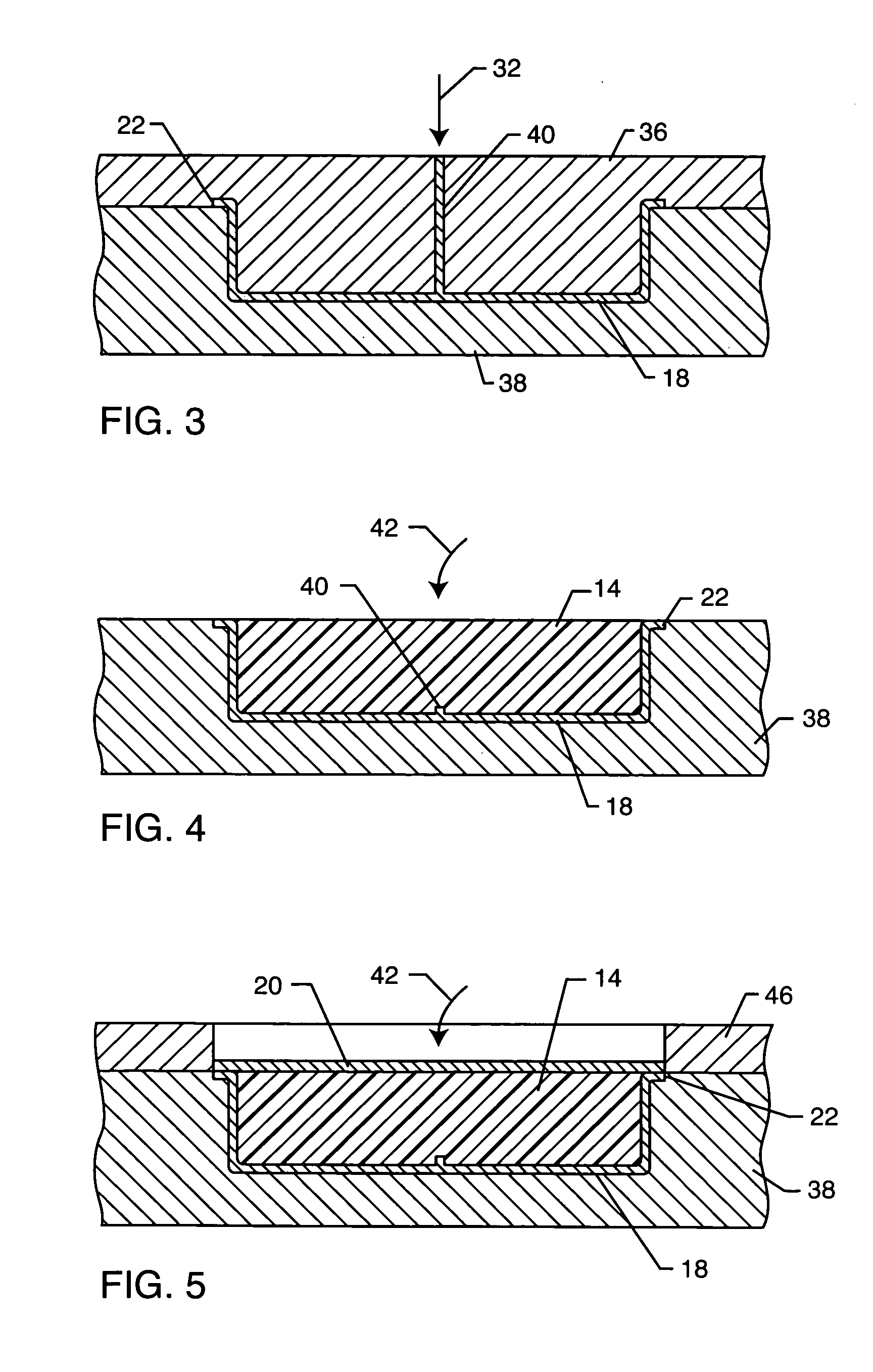[0004] Manual implements generally incorporate a
handle or related structure having a size and shape for appropriate manual grasping and manipulation of the implement during normal intended use. In one common form, the
handle structure comprises an elongated rigid element having one end securely connected to the implement, such as a cooking pot or pan, a hair
brush, a tool head, etc. In another common form, the manual implement is normally grasped directly about the body thereof, such as in the case of writing and other marking instruments, baseball and softball bats, etc. Other manual implements are adapted for fingertip manipulation and thereby include one or more keypads for fingertip depression, e.g., keyboards, musical instruments such as a clarinet, saxophone, trumpet and the like. Still other manual implements incorporate handle-like structures of alternative or complex shapes, such as circular structures adapted for finger or fingertip
insertion to manipulation the implement, e.g., scissors and shears, and the like. In this regard, a variety of improved grips and the like have been developed in recent years for use with such manual implements, primarily to provide a relatively soft and resilient grip structure for enhanced user comfort and / or improved control of the manual implement during normal use thereof.
[0005] In the past, grip structures for relatively large manual implements such as
sports equipment, hand tools, cookware, and hair brushes and the like have generally been limited to relatively soft and resilient rubber or rubber-like
elastomer sleeves or sleeve-like wraps mounted onto the implement handle. While such grip structures beneficially provide a degree of
cushioning for improved user comfort, the relative deformation of such grip structures during normal use is inherently limited. In particular, such cushioned grip structures are generally incapable of significant shape deformation, and thus have generally not provided a high degree of shape deformation needed to assume a customized ergonomical shape conforming closely to the anatomical contours of an individual user's hand and / or fingers. Such customized ergonomic shape is beneficially conducive to substantially optimized user comfort with substantially minimized user fatigue, by providing anatomical pressure relief while enhancing manual dexterity and improving manual control of the related device or implement.
[0009] In accordance with the invention, a conformable or biomorphic pod and related method of production are provided, wherein the pod defines a soft structure adapted for mounting onto a user-contacted surface of a manual implement or the like, and for shape deformation in response to minimal pressure applied thereto, i.e., by contact with some portion of the body including but not limited to the fingers, fingertips, and hands, and for retaining a deformed configuration substantially in the absence of continued application of manual pressure. The pod includes a viscous and tacky gel material encased or contained within a
closed chamber or cavity defined at least in part by a relatively thin and easily deformed outer
skin providing minimal deformation resistance to pod deformation and shape conformance to a substantially customized ergonomic shape conforming with the anatomical contours of the individual user. In a preferred form, the encased gel material is a coagulated or partially coagulated gel such as a
silicone-based gel material adapted for deformation in response to minimal applied manual pressure, and for substantially pressureless retention of the as-deformed shape, followed by shape retention for a time
delay period following user release (at least about two seconds or more) before relatively slow return (at least about four seconds or more) to an initial nondeformed shape.
[0012] In use, when the conformable pod is mounted onto a manual implement or the like at a position for user contact during normal implement use, the outer skin is exposed for shape deformation in response to a relatively light or minimal applied manual or tactile pressure or the like. Such shape deformation of the outer skin is accompanied by a corresponding or conforming displacement of the gel material contained within the pod cavity, wherein this gel material tends to retain the deformed shape upon continued contact by the user but without requiring any significant continued application of manual or tactile pressure or the like. Thereafter, following user release of the pod, the gel material exhibits a memory characteristic causing the pod to initially retain the deformed shape following user release for a time
delay period of at least about two seconds, and then return relatively slowly over a period of at least about four seconds to its initial nondeformed shape.
[0014] In one preferred form and method, the skin may incorporate a textured pattern and / or multiple folds in a corrugated configuration at one or more locations or zones for further reducing the requisite tactile force or the like required to deform the pod skin thereby displacing the contained gel material within the enclosed chamber. In this construction, the patterned or folded skin accommodates close control over the timing and / or direction of skin and
resultant overall pod displacement. In a modified form, the patterned or folded skin zone or zones may each include a region of reduced or variable skin wall thickness. In each configuration, following user release, the gel material encased by the skin returns slowly to an initial, substantially nondeformed shape.
 Login to View More
Login to View More  Login to View More
Login to View More 


